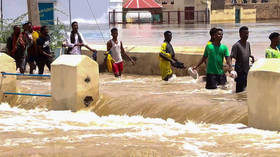East Africa hit by flooding

Floods caused by torrential rains have led to deaths and displaced thousands of residents in the Somali Region of Ethiopia, the local government reported on Saturday.
“More than 20 people died in the floods at this stage, and more than 12,000 families were displaced,” the Somali Regional State Communication Office said in a statement. The destruction of bridges and roads has reportedly made it difficult to reach the affected areas, thus complicating rescue efforts.
The Le Monde newspaper has attributed the above-average rainfall in East Africa between October and December to the El Nino weather phenomenon, citing data from the UN Humanitarian Coordination Office (OCHA). Because of El Nino, the Pacific jet stream moves further south and east, which often brings a rise in temperatures in some regions and heavy rains in others, including East Africa.
“Floods due to heavy rains have affected at least 405,652 people, with fourteen deaths” since the start of monsoon season in Somali Region, which runs from October to December, the OCHA reported on Saturday. “At least 47,100 people have relocated to higher grounds to avoid the risk of flooding,” it added.
The areas surrounding the banks of the Juba River have also experienced flooding in Somalia’s Jubbaland state due to the heavy rains that started last month.
Earlier this year, the Somalian town of Beledweyne was submerged due to flooding of the Shabelle River, forcing around 250,000 people to leave their homes.
Meanwhile, three weeks ago Ghana was also affected by flooding. Over 4,000 people were forced to evacuate their homes when the Akosombo Dam broke during the rainy season.
The recent bouts of severe weather have affected nearly two million people and washed away thousands of livestock animals in Burundi, Djibouti,Kenya, Ethiopia, Somalia, Tanzania, South Sudan and Uganda.
“Climate change is making floods more frequent and severe … There is an urgent need to invest in climate adaptation measures to protect communities from the devastating impacts of floods and other adverse weather conditions,” the Kenya Red Cross Society has stated.













